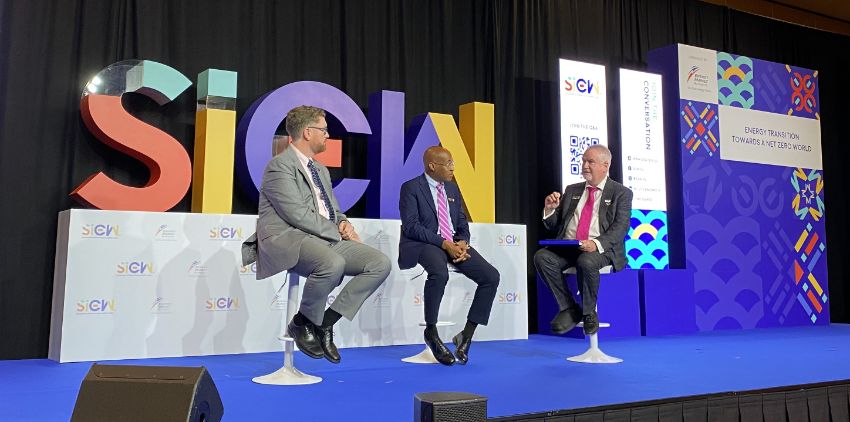Unlocking the potential of cross-border energy solutions. Anthony Cebokli, Associate, Infrastructure Advisory - Deal Advisory, KPMG Services Pte Ltd Singapore, reports. This article is contributed by KPMG - the official Content Partner for SIEW 2023.

In the pursuit of sustainable energy, ASEAN faces pivotal decisions. In his opening remarks, H.E. Jonathan Kaplan, Ambassador, U.S. Embassy Singapore, underscored the need for resiliency as global energy transitions unfold. This session was a gateway to unveiling the possibility of subsea cables and the essence of regional collaboration. It spotlighted the crucial role of energy in realising global sustainability goals.
The feasibility and potential of subsea cables
Dr. Peter F. Green, Deputy Laboratory Director for Science and Technology; Chief Research Officer; Alliance Senior Vice President, National Renewable Energy Laboratory (NREL), emphasised the importance of regional interconnection in harnessing renewable resources for clean energy. He discussed the feasibility of subsea cable projects in ASEAN, highlighting that subsea cables can mitigate various challenges and offer substantial economic benefits.
Dr. Green pointed out that the cost of these projects is reasonable, and with economies of scale and technological advancements like superconductivity, costs are expected to decrease over time. He also underlined the role of job creation and the potential for regional grid resilience through interconnection. His insights emphasised the transformative potential of renewable energy in ASEAN.
"One of the most important ways to achieve this goal is by connecting power systems between regions or countries, allowing access to renewable resources such as solar or nuclear energy. This approach reduces reliance on fossil fuels, minimises waste, and offers socioeconomic benefits. Subsea cables, like those used in Europe, can make this possible," said Dr. Green.
Follow us for more timely updates on X (formerly Twitter) and Telegram.
Unlocking offshore wind's economic potential: A path to decarbonisation and job creation
Dr. Kenneth R. Vincent, Director of the Office of Asian Affairs, Department of Energy, United States of America, underscored the multifaceted benefits of offshore wind energy, going beyond emissions reduction to emphasise the substantial economic advantages, particularly in supply chain.
He discussed his role in the unique initiative to help countries decarbonise through collaboration and highlights the focus on job creation as a core priority. The project seeks to generate economic benefits across supply chains, creating job opportunities and helping with workforce development in partner countries. However, he acknowledged the need for further development in monetising grid services and business models for renewable assets.
"I do think that there's some 'pencil sharpening,' as we say, in terms of figuring out how to monetise grid services and come up with business models where these assets get paid for because I don't think we've completely solved that yet," said Dr. Vincent.
Superconductivity and regional collaboration for a greener future
Mike Hayes, Climate Change and Decarbonisation Leader, Global Head of Renewable Energy, KPMG International, emphasised the importance of thinking long-term and adopting innovative solutions in the renewable energy sector. He cited his experience in Northwestern Europe, where regional collaboration is working effectively. He was confident that soon ASEAN will have a regional energy trading system that leverages renewable resources to reduce reliance on fossil fuels.
Mr Hayes, along with the other speakers, highlighted the need for collaboration, sharing experiences and expertise to address challenges collectively. Despite challenges such as subsea cable maintenance and critical minerals, he expressed optimism about the industry's innovation and its potential to transform the regional energy landscape.
"Actually, when you look at our offshore wind resource, it's one of the largest in the world. We will never come close to utilising it all. That's why interconnection and conversion into hydrogen and green ammonia solutions are long-term strategies," said Mr Hayes.
This session highlighted the feasibility of multilateral collaboration among ASEAN members and the potential for using subsea cables. Not only is multilateral collaboration feasible, it’s also an opportunity to create jobs and spur economic growth across the region. The transition towards a net zero world is not only a global goal but also an imminent reality for ASEAN, promising a brighter and more sustainable future. By embracing the technology of subsea cables and fostering collaborative regional strategies, ASEAN is poised to transform its energy landscape and lead the way towards a more sustainable and prosperous future for all its member nations.
Follow us for more timely updates on X (formerly Twitter) and Telegram.